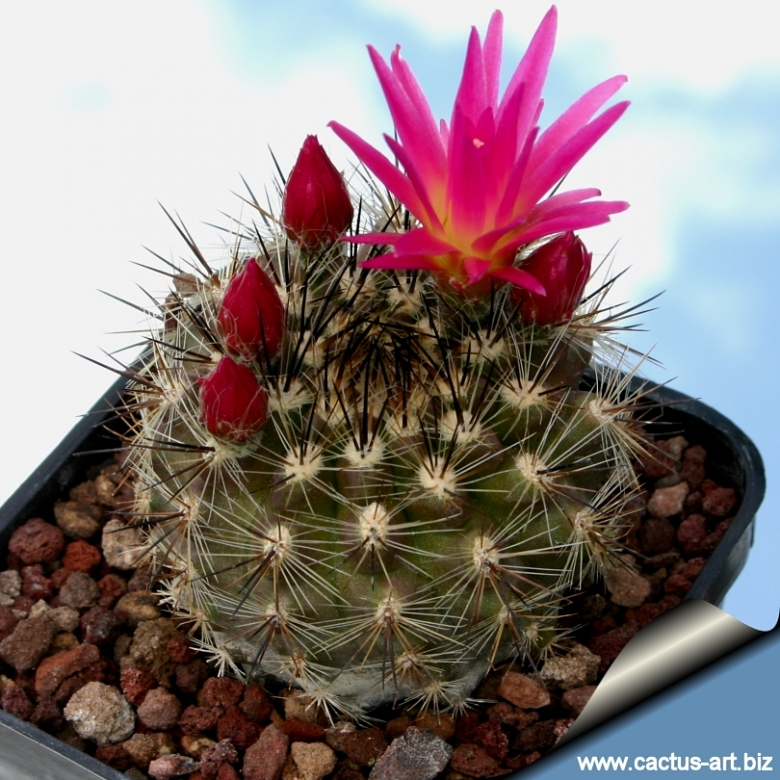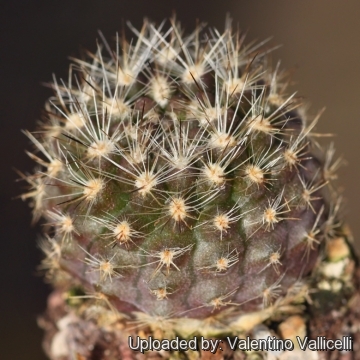Donate now to support the LLIFLE projects.
Your support is critical to our success.
Your support is critical to our success.
Accepted Scientific Name: Eriosyce villosa (Monv.) Katt.
Eriosyce (Cactac.) gen. revis. & ampl. (Succ. Pl. Res., 1) 119 (1994)

Neoporteria polyraphis Photo by: Cactus Art
This plant is now considered nothing else than Eriosyce villosa, but the plants in cultivation are not exactly the same, the spines are shorter and the flowers are a bit more pointed
This plant is now considered nothing else than Eriosyce villosa, but the plants in cultivation are not exactly the same, the spines are shorter and the flowers are a bit more pointed
Synonyms:
- Neoporteria polyraphis (Pfeiff. ex Salm-Dyck) Backeb.
- Bridgesia polyraphis (Pfeiff. ex Salm-Dyck) Backeb.
- Chileniopsis polyrhaphis (Pfeiff.) Backeb. in Backeb. & F.M.Knuth
- Echinocactus polyrhaphis (Pfeiff. ex Salm-Dyck)
- Neoporteria polyraphis (Pfeiff. ex Salm-Dyck) Backeb.
See all synonyms of Eriosyce villosa
back
Accepted name in llifle Database:Eriosyce villosa (Monv.) Katt.
Eriosyce (Cactac.) gen. revis. & ampl. (Succ. Pl. Res., 1) 119 (1994)
Synonymy: 24
- Eriosyce villosa (Monv.) Katt.
- Bridgesia villosa Backeb.
- Cactus villosus Monv.
- Chileniopsis villosa (Monv.) Backeb. in Backeb. & F.M.Knuth
- Euporteria villosa (Monv.) Kreuz. & Buining
- Neoporteria villosa (Monv.) A.Berger
- Chileniopsis villosa var. nigra (A.Berger ex A.Berger) Y.Itô
- Chileniopsis villosus var. niger A.Berger
- Neoporteria polyraphis (Pfeiff. ex Salm-Dyck) Backeb.
- Bridgesia polyraphis (Pfeiff. ex Salm-Dyck) Backeb.
- Chileniopsis polyrhaphis (Pfeiff.) Backeb. in Backeb. & F.M.Knuth
- Echinocactus polyrhaphis (Pfeiff. ex Salm-Dyck)
- Neoporteria polyraphis (Pfeiff. ex Salm-Dyck) Backeb.
- Neoporteria villosa var. atrispinosa (Backeb.) Donald & G.D.Rowley
- Chilenia atrispinosa Backeb.
- Euporteria atrispinosa Kreuz. & Buining
- Neoporteria atrispinosa Backeb.
- Neoporteria villosa var. cephalophora (Backeb.) Donald & G.D.Rowley
- Chilenia cephalophora Backeb.
- Euporteria cephalophora Kreuz. & Buining
- Neoporteria cephalophora Backeb.
- Neoporteria villosa var. laniceps (F.Ritter) A.E.Hoffm.
- Neoporteria laniceps F.Ritter
- Neoporteria planiceps F.Ritter
back

Neoporteria polyraphis Photo by: Valentino Vallicelli
Send a photo of this plant.
The gallery now contains thousands of pictures, however it is possible to do even more. We are, of course, seeking photos of species not yet shown in the gallery but not only that, we are also looking for better pictures than those already present. Read More...
The gallery now contains thousands of pictures, however it is possible to do even more. We are, of course, seeking photos of species not yet shown in the gallery but not only that, we are also looking for better pictures than those already present. Read More...
| Your Actions | |
|---|---|
| Back to Neoporteria index | |
| Back to Cactaceae index | |
 |
Back to Cacti Encyclopedia index |








